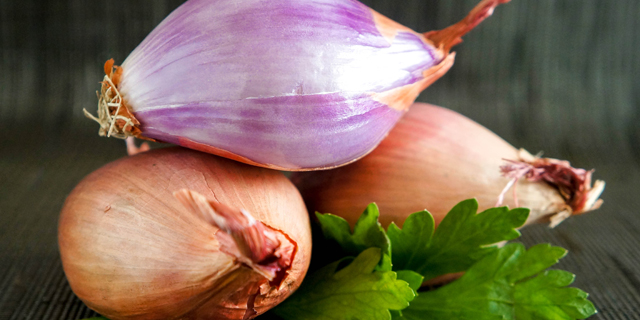With their sweet and subtle onion flavoring, shallots are an ingredient renowned not only for their taste but for their dietary value. Shallots are rich in cell protecting antioxidants, iron (a necessary nutrient for red blood cells, cell regulating potassium) and fiber, which helps keep your belly satisfied. Clocking in at just 72 calories per 100 gram serving, it’ s no wonder we enjoy shallots with any dish, whether breakfast, lunch or dinner!
How do I pick the best shallots?
Shallots are available all year round, but the best time to enjoy these gems are between winter and spring. Like garlic, shallots come in a tight knit bulb made up of smaller cloves. Each clove, as well as the bulb, is encased in paper thin skin that ranges in color from copper to gray. The flesh of a shallot, on the other hand, ranges from a bright purple to a light pink. No matter the color, shallots should be firm and dry with plump cloves. Avoid shallots that look wrinkled or shriveled, as well as those that look moldy or moist. Shallots also come in three sizes – small, medium and jumbo. The smaller the shallot, or cloves, the milder the taste, so choose wisely.
What can I make with shallots?
Because of their subtle taste, shallots can be incorporated into almost any meal. Saute and add shallots to a Quinoa Salad, use instead of onion in Fresh Grapefruit Salsa, or caramelize and sprinkle on a Brussels Sprouts Pizza for extra flavor. Whether you bake, broil, saute, or enjoy them raw, shallots are a wonderfully versatile ingredient that lends itself to almost any meal.
Prep shallots by removing cloves and peeling off their casings. You can peel the casings off in a few ways. Use a paring knife and carefully slice through the skin, then pull the casing off. You can also slice off the stem end of a clove and peel the skin back or, if aesthetics don’t matter, smash it with the bottom of a mug or the widest part of a knife and remove casings.
And storage? Shallots that have their casings intact can be stored in a cool, dark, well ventilated place and remain fresh for up to a month. If you prefer counter storage you’ll have about 2 weeks before they begin to sprout. If the casings have been peeled off or you’re storing part of a shallot you didn’t use, refrigerate in the crisper and use within one week. Don’t worry too much about storing. With so many scrumptious recipes to choose from they won’t last long!


![Making Mealtime Matter with La Familia: Easy Sofrito [Video]](https://thelatinkitchen.com/wp-content/uploads/2015/10/sofrito-shutterstock__0-500x383.jpg)
![Easy Latin Smoothies: Goji Berry Smoothie [Video]](https://thelatinkitchen.com/wp-content/uploads/2015/12/goji_berry-shutterstock_-500x383.jpg)
















![Fun and Fast Recipes: Fiesta Cabbage Salad [Video]](https://thelatinkitchen.com/wp-content/uploads/2015/11/fiesta_cabbage_slaw-shutterstock_-500x383.jpg)









